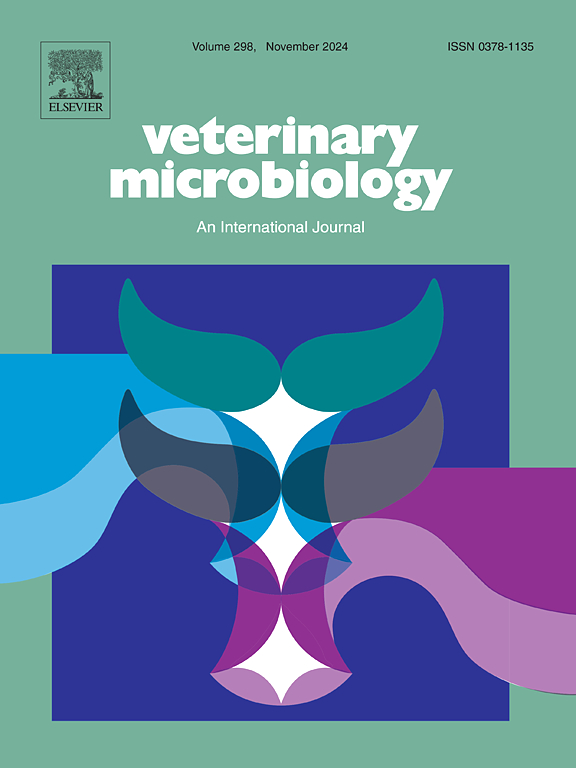Lumpy skin disease virus enters into host cells via dynamin-mediated endocytosis and macropinocytosis
IF 2.4
2区 农林科学
Q3 MICROBIOLOGY
引用次数: 0
Abstract
Lumpy skin disease virus (LSDV), a ruminant poxvirus of the Capripoxvirus genus, is the etiologic agent of an economically important cattle disease categorized as a notifiable disease by the World Organization for Animal Health. However, the endocytic pathway and their regulatory molecules have not been characterized for LSDV. In the present study, specific pharmacological inhibitors were used to analyze the mechanism of LSDV entry into Mardin-Darby Bovine Kidney cell (MDBK) and bovine mammary epithelial cell (BMEC). The results showed that LSDV entered MDBK and BMEC cells depends on low-pH conditions and dynamin. However, the inhibitor of caveolae- and clathrin-mediated endocytosis cann’t inhibit LSDV entry into MDBK and BMEC cells. Furthermore, treatment with specific inhibitors demonstrated that LSDV entry into MDBK and BMEC cells via macropinocytosis depended on the Na1/H1 exchanger (NHE) but not phosphatidylinositol 3-kinase (PI3K). In addition, results demonstrated that these inhibitors inhibited LSDV entry but did not have effect on LSDV binding. Taken together, our study demonstrated that LSDV enters MDBK and BMEC cells through macropinocytosis pathway in a low-PH- and dynamin-dependent manner while independent on PI3K. Results presented in this study potentially provides insight into the entry mechanisms of LSDV, and it may facilitate the development of therapeutic interventions.
瘤状皮肤病病毒通过达纳明介导的内吞和大蛋白细胞吞噬作用进入宿主细胞。
结节性皮肤病病毒(LSDV)是一种反刍动物痘病毒,属于 Capripoxvirus 属,是一种具有重要经济价值的牛病的病原体,被世界动物卫生组织列为应通报的疾病。然而,LSDV 的内细胞途径及其调控分子尚未定性。本研究利用特异性药理抑制剂分析了 LSDV 进入马尔丁-达比牛肾细胞(MDBK)和牛乳腺上皮细胞(BMEC)的机制。结果表明,LSDV进入MDBK和BMEC细胞依赖于低pH条件和dynamin。然而,洞穴内和凝集素介导的内吞抑制剂不能抑制 LSDV 进入 MDBK 和 BMEC 细胞。此外,用特异性抑制剂处理后发现,LSDV 通过大蛋白胞吞作用进入 MDBK 和 BMEC 细胞依赖于 Na1/H1 交换子(NHE),而不是磷脂酰肌醇 3- 激酶(PI3K)。此外,研究结果表明,这些抑制剂抑制了 LSDV 的进入,但对 LSDV 的结合没有影响。综上所述,我们的研究表明,LSDV 是以低 PH 和达达敏依赖的方式通过巨细胞吞噬途径进入 MDBK 和 BMEC 细胞的,而不依赖于 PI3K。本研究的结果可能有助于深入了解 LSDV 的进入机制,并有助于开发治疗干预措施。
本文章由计算机程序翻译,如有差异,请以英文原文为准。
求助全文
约1分钟内获得全文
求助全文
来源期刊

Veterinary microbiology
农林科学-兽医学
CiteScore
5.90
自引率
6.10%
发文量
221
审稿时长
52 days
期刊介绍:
Veterinary Microbiology is concerned with microbial (bacterial, fungal, viral) diseases of domesticated vertebrate animals (livestock, companion animals, fur-bearing animals, game, poultry, fish) that supply food, other useful products or companionship. In addition, Microbial diseases of wild animals living in captivity, or as members of the feral fauna will also be considered if the infections are of interest because of their interrelation with humans (zoonoses) and/or domestic animals. Studies of antimicrobial resistance are also included, provided that the results represent a substantial advance in knowledge. Authors are strongly encouraged to read - prior to submission - the Editorials (''Scope or cope'' and ''Scope or cope II'') published previously in the journal. The Editors reserve the right to suggest submission to another journal for those papers which they feel would be more appropriate for consideration by that journal.
Original research papers of high quality and novelty on aspects of control, host response, molecular biology, pathogenesis, prevention, and treatment of microbial diseases of animals are published. Papers dealing primarily with immunology, epidemiology, molecular biology and antiviral or microbial agents will only be considered if they demonstrate a clear impact on a disease. Papers focusing solely on diagnostic techniques (such as another PCR protocol or ELISA) will not be published - focus should be on a microorganism and not on a particular technique. Papers only reporting microbial sequences, transcriptomics data, or proteomics data will not be considered unless the results represent a substantial advance in knowledge.
Drug trial papers will be considered if they have general application or significance. Papers on the identification of microorganisms will also be considered, but detailed taxonomic studies do not fall within the scope of the journal. Case reports will not be published, unless they have general application or contain novel aspects. Papers of geographically limited interest, which repeat what had been established elsewhere will not be considered. The readership of the journal is global.
 求助内容:
求助内容: 应助结果提醒方式:
应助结果提醒方式:


